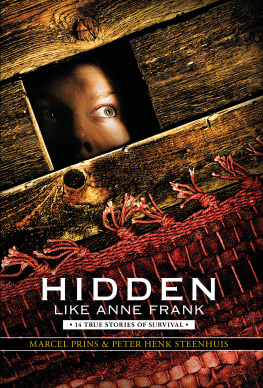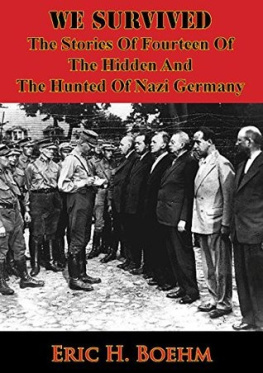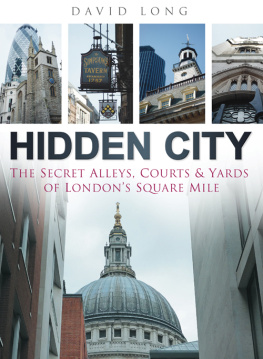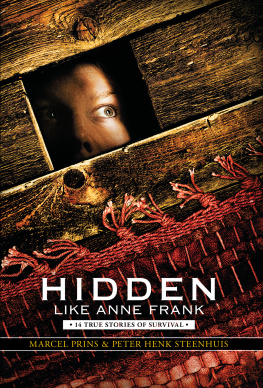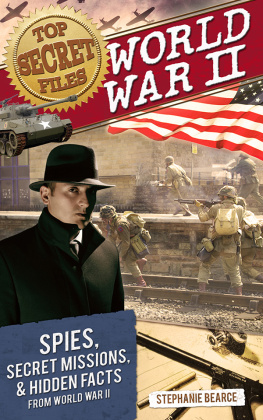
CONTENTS
Originally published as Ondergedoken als Anne Frank , copyright 2011 by Marcel Prins and Peter Henk Steenhuis
Translation by Laura Watkinson copyright 2014 by Scholastic Inc.
All rights reserved. Published by Arthur A. Levine Books, an imprint of Scholastic Inc., Publishers since 1920 , by arrangement with Em. Queridos Uitgeverij BV, Amsterdam, the Netherlands. SCHOLASTIC and the LANTERN LOGO are trademarks and/or registered trademarks of Scholastic Inc.
Library of Congress Cataloging-in-Publication Data
Prins, Marcel, 1962 author.
[Ondergedoken als Anne Frank. English]
Hidden like Anne Frank : fourteen true stories of survival / Marcel
Prins and Peter Henk Steenhuis ; translated by Laura
Watkinson. First American edition.
pages cm
Summary: A collection of fourteen eye-opening first-person accounts that share what it was like to go into hiding as children in the Netherlands during World War II Provided by publisher.
ISBN 978-0-545-54362-0 (hardback) 1. Jewish children in the Holocaust Netherlands Biography. 2. Hidden children (Holocaust) Netherlands Biography. 3. Holocaust, Jewish (19391945) Netherlands Personal narratives. 4. World War, 19391945 Netherlands Personal narratives. 5. Netherlands Biography. I. Steenhuis, Peter Henk, 1969 author. II. Title.
DS135.N6A162513 2014
940.53180922 dc23
[B]
2013040908
Photographs of the Hollandsche Schouwburg, Amsterdam; the street scene in front of the Hollandsche Schouwburg; and prisoners in the yard at the Hollandsche Schouwburg NIOD Institute for War, Genocide, and Holocaust Studies.
Photographs of Jacks hiding place in Zeist, as well as contemporary portraits of the hidden children Marcel Prins.
Photograph of Hirsch and Co. archief De Arbeiderspers/Stadsarchief Amsterdam.
Photograph of Westerbork transit camp used with the permission of Herinneringscentrum Kamp Westerbork.
Chapter opener maps by Marcel van der Drift.
All other photographs are from private collections of the interviewees, and are used with permission.
First American edition, April 2014
Cover art and design 2014 by Phil Falco
e-ISBN 978-0-545-75278-7
All rights reserved under International and Pan-American Copyright Conventions. No part of this publication may be reproduced, transmitted, downloaded, decompiled, reverse engineered, or stored in or introduced into any information storage and retrieval system, in any form or by any means, whether electronic or mechanical, now known or hereafter invented, without the express written permission of the publisher. For information regarding permission, write to Scholastic Inc., Attention: Permissions Department, 557 Broadway, New York, NY 10012.
For my mother, who inspired me to start this project
M.P.

This book tells the stories of fourteen people who had to go into hiding during World War II because they were Jewish. Adolf Hitler, the leader of the Nazi Party in Germany, believed the Jews were the cause of all evil in the world. So they had to be destroyed. My mother was considered to be a part of that evil. But she was one of the lucky ones: She was hidden, and she survived.
At that time summer 1942 she was nearly six years old. Even as a little boy, I was curious about the story of her time in hiding. She told me what had happened. The exciting parts and the times when she had been scared or sad made a particularly strong impression on me.
Later, when I started to look into the experiences of other people who went into hiding, I found out that their stories were all very different. And that many of the people who went into hiding had not survived the war, because someone revealed their location or the Nazis found them during raids. About 28,000 Jews were hidden in the Netherlands. Roughly 16,000 survived and 12,000 were caught or betrayed in hiding. The most famous example is, of course, Anne Frank, whose diary has been read by people all over the world.
But what did going into hiding actually involve? Where did you go? How did you know who to trust? How did you find money to pay for your hiding place? What did you do when you were frightened? These are the kinds of questions that I asked men and women who are old now but who were young boys and girls during the war. You can read about their experiences in this book. The first story is my mothers.
There is a website accompanying the book: www.hiddenlikeannefrank.com. There you can see more photographs, watch short animated clips, and hear a part of each persons story as it was told to me. You can also learn about other young people who went into hiding, whose stories are not included here.
In this book, weve included a map at the beginning of every chapter that shows the places in the Netherlands where that person went into hiding. Sometimes it was only one address, but it was usually several locations. One of the people in this book hid in more than forty-two different places! There is also an interactive map on the website, where you can click on a dot on the map to hear and see the story that happened in that place.
Read, look, and listen!
Marcel Prins



Rita with her mother, Bertha Degen-Groen, c. 1939
In 1939, when I was three years old, my father was called up for the army. The camp was located near the Grebbe Line, which was an important point of defense. My mother and I went there on the train twice to visit him. He was out there with a group of soldiers, all of them in uniform, and I remember thinking how strange they looked. They were living in a large farmhouse. Mom and I were allowed to stay overnight in a separate room. I thought it was kind of fun.
When the war broke out, my fathers regiment had to march toward the Grebbeberg, a hill that was in a strategic position. There was heavy fighting, and lots of men were wounded and dying. My father realized it was going badly, so he grabbed his bike and rode back to Amsterdam. He arrived in the middle of the night, without his rifle and his kit bag. He must have gotten rid of them somewhere.
My father always liked to know exactly what was going on, so he found a job with the Jewish Council , which had been founded in 1941 on the orders of the Germans to represent the Jewish community in the Netherlands. My father was on guard duty when one of the first groups of Jewish people was transported out of Amsterdam. What he saw made him decide to send me into hiding right away. My parents went into hiding that same week. He had already arranged hiding places for all of us, not just for the immediate family but also for his parents and for all of my mothers brothers and sisters. But they never made use of them. It wont be as bad as all that, they said.
Soon after my parents went into hiding, their house was Pulsed, or cleared out. The Germans had given Abraham Puls and his company the job of emptying the houses of Jews who had gone into hiding or who had been rounded up during a raid . We were lucky: Our neighbors, who were good people, had a key to our house, and they took everything they could carry and hid it for us. After the war, we got back our photographs, a set of cutlery, a figurine, and a clock.

